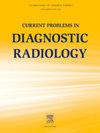Assessing asymmetric enhancement on breast MRI: Besting the diagnostic challenge with imaging and clinical clues
IF 1.5
Q3 RADIOLOGY, NUCLEAR MEDICINE & MEDICAL IMAGING
引用次数: 0
Abstract
Breast magnetic resonance imaging (MRI) has the highest sensitivity for breast cancer detection compared to other breast imaging modalities such as mammography and ultrasound. As a functional modality, it captures the increased angiogenic activity of breast cancer through gadolinium-based contrast enhancement. Normal breast tissue also enhances, albeit in distinct patterns termed background parenchymal enhancement (BPE). Asymmetric enhancement, i.e., when one breast enhances more prominently than the other, can pose a diagnostic challenge for interpreting radiologists as distinguishing suspicious nonmass enhancement (NME) versus benign asymmetric BPE can be difficult. Correlating with patient history and imaging findings can help differentiate benign versus suspicious patterns of asymmetric enhancement. We present a collection of cases illustrating clues helpful for assessing asymmetric enhancement encountered on breast MRI.
评估乳腺磁共振成像的非对称性增强:利用成像和临床线索应对诊断挑战。
与乳房x光摄影和超声波等其他乳房成像方式相比,乳房磁共振成像(MRI)对乳腺癌的检测灵敏度最高。作为一种功能模式,它通过基于钆的对比增强来捕捉乳腺癌血管生成活性的增加。正常乳腺组织也会增强,尽管是不同的背景实质增强(BPE)。不对称增强,即当一个乳房比另一个乳房更明显时,可能会给放射科医生的诊断带来挑战,因为区分可疑的非肿块增强(NME)和良性的不对称BPE可能很困难。与患者病史和影像学表现相关联有助于区分良性与可疑的不对称增强。我们提出了一组病例,说明了有助于评估乳房MRI上遇到的不对称增强的线索。
本文章由计算机程序翻译,如有差异,请以英文原文为准。
求助全文
约1分钟内获得全文
求助全文
来源期刊

Current Problems in Diagnostic Radiology
RADIOLOGY, NUCLEAR MEDICINE & MEDICAL IMAGING-
CiteScore
3.00
自引率
0.00%
发文量
113
审稿时长
46 days
期刊介绍:
Current Problems in Diagnostic Radiology covers important and controversial topics in radiology. Each issue presents important viewpoints from leading radiologists. High-quality reproductions of radiographs, CT scans, MR images, and sonograms clearly depict what is being described in each article. Also included are valuable updates relevant to other areas of practice, such as medical-legal issues or archiving systems. With new multi-topic format and image-intensive style, Current Problems in Diagnostic Radiology offers an outstanding, time-saving investigation into current topics most relevant to radiologists.
 求助内容:
求助内容: 应助结果提醒方式:
应助结果提醒方式:


